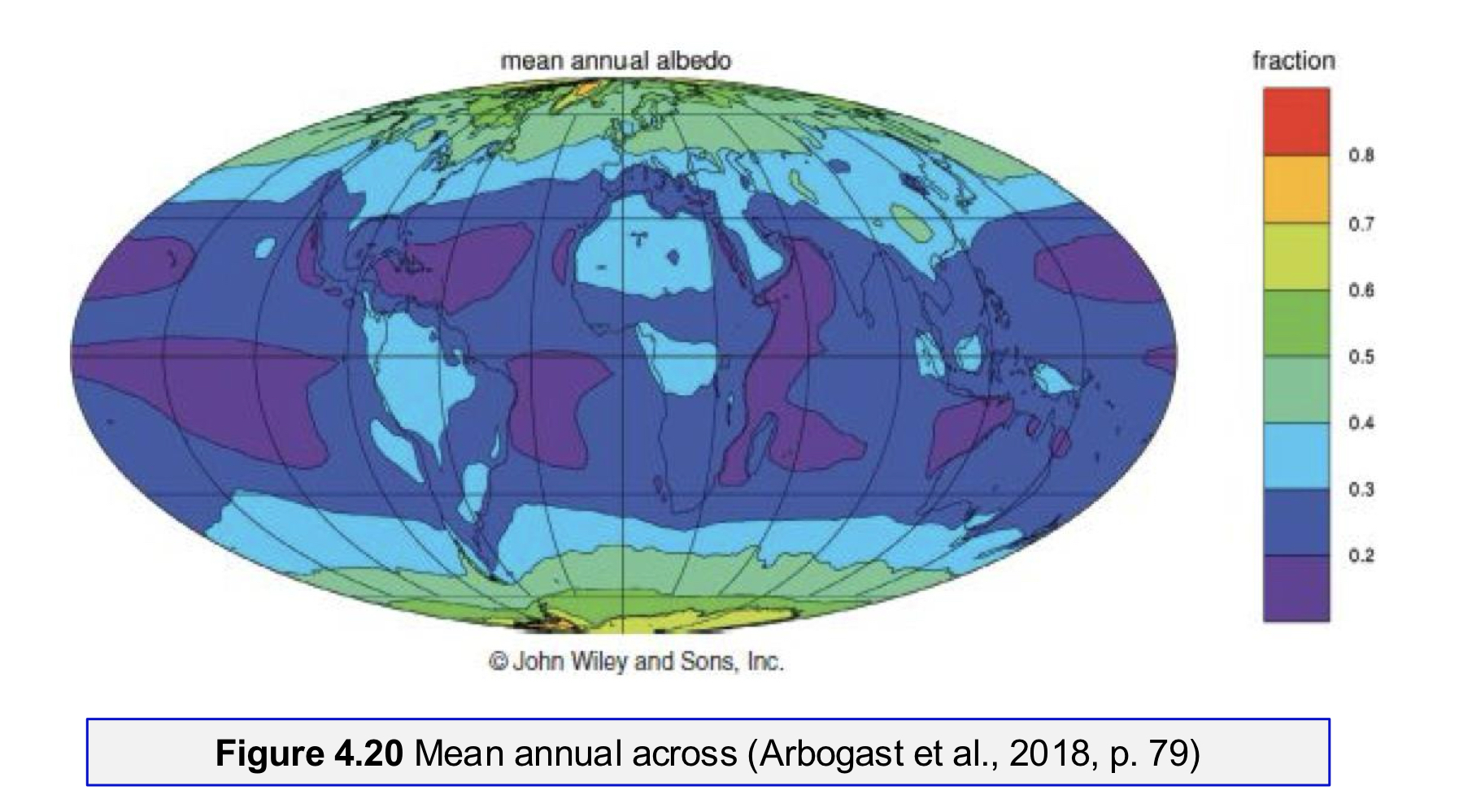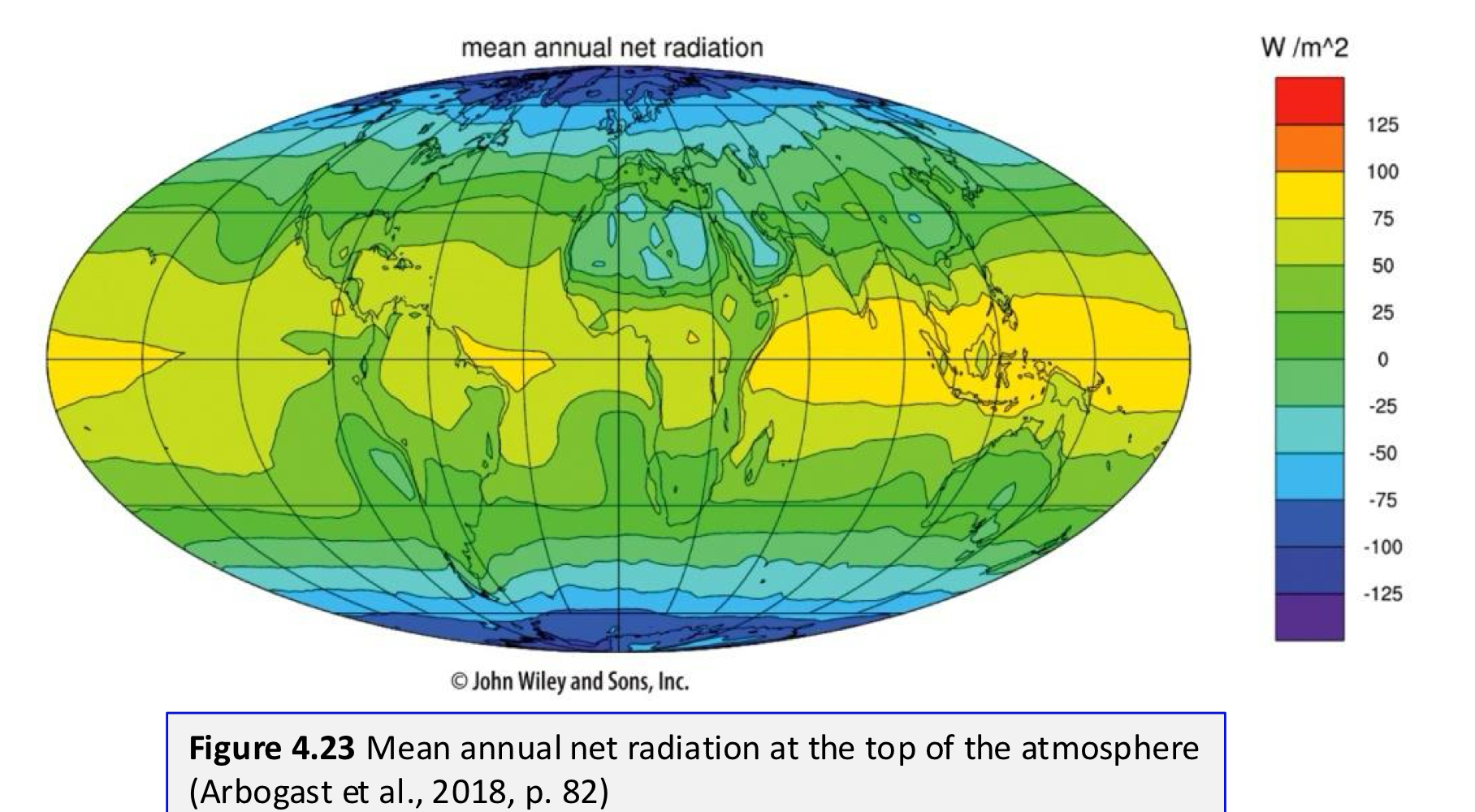Section E: Global Energy System
1/66
There's no tags or description
Looks like no tags are added yet.
Name | Mastery | Learn | Test | Matching | Spaced |
|---|
No study sessions yet.
67 Terms
what is electromagnetic energy
form of energy that propagates as both electric and magnetic waves, travels in packets of energy called photons
electromagnetic energy can be described by
wavelength, frequency, energy
everything above ___ emits electromagnetic energy
absolute zero (0°K=-273°C)
first principle of electromagnetic radiation
inverse relationship between temperature of an object and wavelength that it emits
wein’s law
hotter objects emit shorter wavelengths
second principle of electromagnetic radiation
direct relationship between the absolute temperature and the amount of radiation
stephan-boltzmann law
hotter objects emit more radiation than cooler objects
earth emits less radiation than the sun
infrared radiation
(0.7 to 1000µm)
earth radiation is entirely (thermal) infrared (long wave)
45% of the solar energy infrared (short wave)
visible light
(0.4 to 0.7µm) 47% of the solar energy coming from the sun.
short wave
ultraviolet
(0.01 to 0.4µm)
8% of solar energy
most filtered by ozone layer
short wave
what is the temperature of the sun
6000°C at surface, 16 million°C internal
how far is the earth from the sun
150 million km
what is the speed of light
300,000km/s
what creates electromagnetic radiation
nuclear fusion (H→He)
how much solar radiation does earth intercept
a very small amount
solar radiation travels through space with or without loss of energy
without
how does the intensity of solar radiation change with distance from the sun
it diminishes
what is the inverse square law of intensity
I/d² where
I=intensity of radiation at 1 unit distance
d=distance travelled in those units
insolation
incoming solar radiation
explain solar constant
total solar irradiance
almost constant amount of solar insolation received at top of atmosphere per square meter over a year
what is the numerical value of the solar constant
1367 W/m²
what are the three ways solar radiation can be modified
absorption, reflection, scattering
UVA
most reaches earth, transmits through window glass, what sunscreen blocks
UVB
10% reaches earth, blocked by window glass
UVC
all absorbed by atmosphere
absorption
electromagnetic waves assimilated by that object
reflection
ability of an object to repel electromagnetic waves that strike it. no heating effect
scattering
deflection of light waves in a variety of directions. has no heating effect. depends on wavelength.
why is the sky blue
rayleigh scattering. shorter wavelengths are scattered more easily than longer wavelengths. more blue than purple in electromagnetic spectrum
explain red sunsets
sun is low in the sky and light passes through so much atmosphere that all the blues are scattered away leaving longer wavelengths like red and orange
how much solar energy reaches the surface of the earth
45% (25% direct and 20% indirect)
how much solar energy doesn’t make it to the earth
55%
explain the greenhouse effect
sun sends shortwave to earth, earth absorbs 45% of it. thermal infrared from earth is radiated back. that longwave from the earth heats up the atmosphere
counterradiation
longwave radiation emitted by the surface absorbed by greenhouse gases and re radiated back towards the surface as longwave
sensible heat
can be sensed (feel and touch) and measured
latent heat
is hidden and cannot be measured. energy stored or released when substance changes state
stored energy lost in several such as
conduction to gases in the atmosphere, removed by evaporation and stored as latent heat, radiation into atmosphere or lost in space
albedo
overall reflectivity of an object or surface

explain it
purple area=low albedo, low latitudes so high angle of incidence. poles have high albedo (ice reflects most of the radiation), low angle of incidence
net radiation
difference between incoming shortwave and outgoing longwave radiation
variations in earth’s net radiation due to
latitude (angle of incidence), seasonality, length of day

explain surplus and deficit
low latitudes=surplus of energy because more incoming than outgoing. high latitudes=deficit because more outgoing than incoming. (low angle of incidence so energy more spread out)
what is the main determinant of intensity of solar radiation received on earth
angle of incidence
the global radiation budget
variations in annual insolation at different latitudes
surface temperature
measure of kinetic energy contained in a region very close to earth’s surface (hot asphalt)
atmospheric temperature
measure of kinetic energy in unit of geographical space within the air. measured at 1.2m above ground
surface and air temperature
measures the amount of sensible heat
temperature is determined by
energy balance of a substance
average annual temperature
avg temp calculated over the course of the year (mean annual temp)
controlled mainly by elevation and latitude
annual temperature range
difference between the avg max and avg min temps over a year at a location (seasonality)
three main large scale geographic factors that influence air temperatures
latitude, seasons, and length of day
explain latitudes as a factor that influences air temp
different angle of incidence causes energy to be directed in smaller of larger surface areas.
low lats: high amounts of solar energy
high lats: lower angle of incidence = less solar energy
explain seasons and length of day as a factor that influences air temp
axial tilt and migration of subsolar point. influences day light length and daily radiation patterns (mid lats)
day length at equator always the same
what is a local factor that influences air temp
maritimes vs continental locations
maritime
places that are located within or near a very large body of water and are more moderate and humid climate
continental
places surrounded by landmasses. more extreme climates (warmer summers and colder winters)
land cools and heats more rapidly than water due to
specific heat, transmission, mobility, evaporative cooling
specific heat
amount of energy it takes to raise the temp of 1 gram of a substance by 1°C
transmission
heat gets spread out in water better than on land
mobility
water disperses heat down through convection. on land it disperses only by conduction (bad at it)
evaporative cooling
evaporation = cooling process (heat is lost). land has some evaporation but a lot less
it takes _ times more energy to heat water than a land substance
5
other factors that influence air temp
altitude, slope aspect, topographic barriers, wind flow patterns
explain altitude as a factor
as altitude increases, atmospheric pressure, temperature and moisture content decreases. but temperature range increases
slope aspect
direction slope is facing
topographic barriers
divert/funnel wind. windward = side that faces wind (wet side). leeward = side sheltered from wind (warm dry side).
wind flow patterns
direction of wind flow can change air temp depending on source of air, its modification and barriers
urban area temps
dry surfaces = less vegetation and less water, stored heat, dark surface= low albedo, fossil fuels = heat byproduct
rural areas temp
more reflective surfaces, wetter surfaces=more water, evaporation + transpiration = evapotranspiration, cools surface